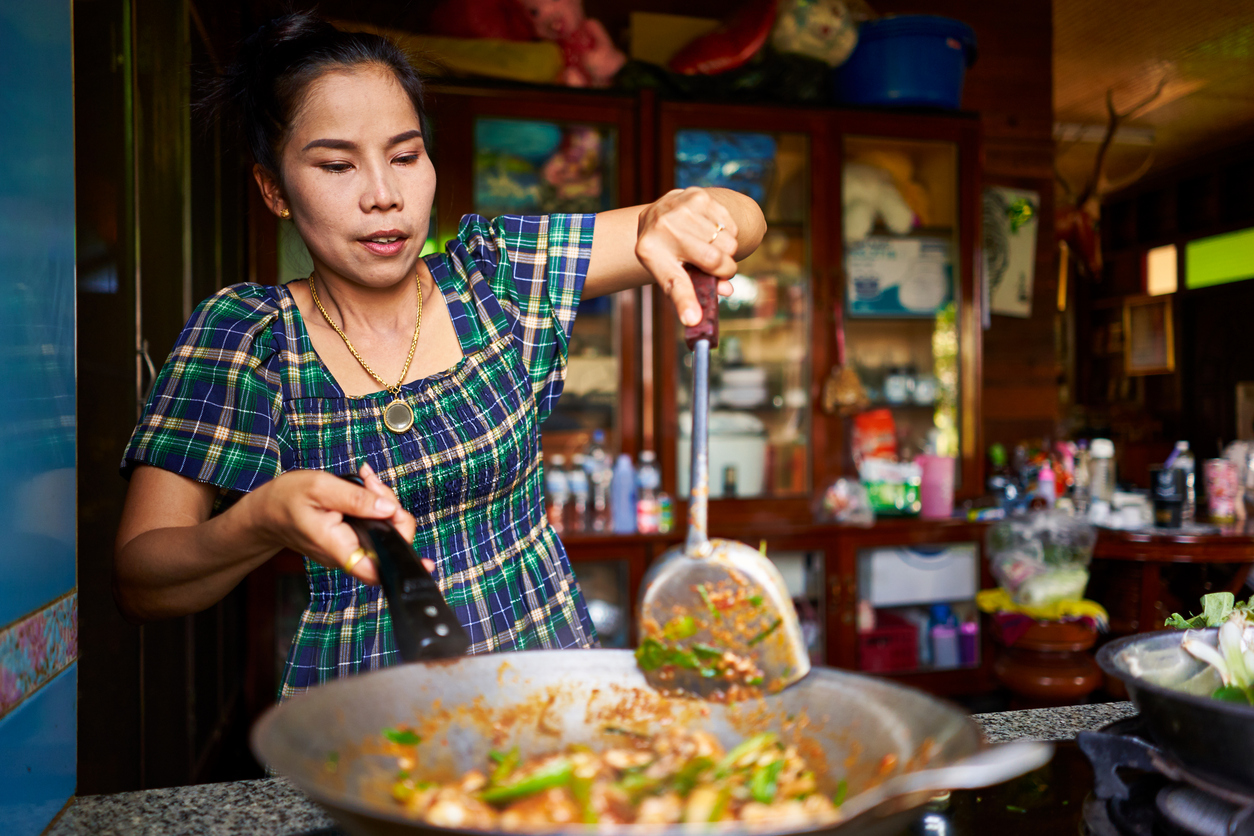
You arrive expecting to learn how to make pad Thai. Maybe a curry. A few tricks to impress people back home. What you don’t expect is to have your senses hijacked by lemongrass, to spend ten minutes grinding a single paste by hand while sweat drips down your back, or to discover that fish sauce and palm sugar have more to say about Thailand than any tour guide ever could.
Taking a cooking class in Thailand isn’t about following a recipe — it’s about stepping inside the heartbeat of Thai culture. It’s noisy, fragrant, fast-paced, and surprisingly personal. And no matter how many times you’ve ordered Thai food back home, nothing prepares you for the feeling of slicing kaffir lime leaves with your own hands, or eating a dish you just made while seated cross-legged on a floor, surrounded by strangers and laughter.
Here’s what it’s really like to take a local cooking class in Thailand — what to expect, what you’ll learn, and why the memory of one perfect green curry will outlast almost everything else from your trip.
First: Where to Take a Class
Cooking schools are everywhere in Thailand — from Bangkok rooftops to Chiang Mai courtyards, from beach bungalows in Koh Lanta to open-air kitchens in rural villages. But the experience varies depending on where you go and what kind of vibe you’re after.
Popular locations include:
- Chiang Mai – Often considered the best place to take a class. Slower pace, access to fresh herbs, and a strong culinary tradition. Many classes here include a visit to the market or even a local farm.
- Bangkok – More urban, more diverse in flavor profiles, often faster-paced. Great for street food-style cooking or modern spins on traditional dishes.
- Southern Thailand (Koh Samui, Phuket, Krabi) – Island classes often emphasize seafood and southern-style curries. Some are held beachside with spectacular views.
Classes range from quick 2-hour sessions to full-day immersions with multiple courses, market tours, and garden visits.
The Market Run: Your First Real Lesson
Most quality classes start with a trip to a local market. It’s not a tourist performance — it’s the real deal. You walk past baskets of fiery chilies, banana blossoms, and five types of basil you didn’t know existed. There are frogs hopping out of buckets, whole fish staring back at you, and smells you can’t quite place — equal parts intoxicating and overwhelming.
Your instructor points things out quickly: “That’s galangal — not ginger. Different. Spicier.” You nod, trying to keep up. “This is holy basil, for stir-fry. That one? Sweet basil — for green curry.”
You realize this isn’t just grocery shopping. It’s language. Geography. History. Identity. All told through produce.
Back at the Kitchen
You arrive at the cooking school — usually an open-air space, with a few gas burners, chopping blocks, and rows of prepped ingredients waiting in neat bowls. But don’t get too comfortable. You’re doing this yourself.
Most classes let you choose from a list of dishes — usually a mix of classics:
- Tom Yum Goong (spicy shrimp soup)
- Pad Thai
- Green curry with chicken
- Papaya salad (Som Tum)
- Sticky rice with mango
You pick a few, and then the real work begins.
The Process: Fast, Fragrant, and Humbling
The instructor demonstrates first, fast and fluid. You try to mimic, awkwardly. You pound your curry paste in a mortar and pestle, sweat dripping off your brow, realizing this takes more time and effort than any recipe book admits.
You fry aromatics — garlic, shallots, chilies — and the scent punches you in the face (in the best way). You add coconut milk to curry and watch the oil separate like a blessing. You crush herbs, tear lime leaves, and sprinkle palm sugar with your fingers. Measurements? Forget them. It’s all by eye, taste, instinct.
There’s no pressure to get it perfect. Thai cooking, as your instructor will remind you, is about balance — sweet, salty, sour, spicy. You taste, adjust, taste again. You learn that fish sauce isn’t a condiment. It’s a foundation.
And somewhere between the third stir and the final squeeze of lime, you stop trying to recreate a restaurant dish and start understanding how Thai food feels.
The Meal: Made by You, Eaten Together
When it’s time to eat, something shifts. You’ve been busy, focused. But now, you sit down. Everyone’s made different dishes, so the table is full of colors and scents — ruby-red chili paste, glowing green curries, golden noodles, purple eggplant, fresh herbs.
You take that first bite of your own food — and it’s good. Not restaurant-perfect. Not the same as back home. Better. Because you made it. Because you understand it now.
There’s a quiet pride at that table, even as people joke about burning their pad Thai or mixing up sugar and salt. You share bites. Swap stories. There’s beer or tea, and probably second helpings.
And then someone says it — quietly but sincerely: “That was one of the best meals I’ve ever had.”
The Unexpected Lessons
- Precision isn’t everything. Thai cooking is more forgiving than it seems. It’s less about accuracy, more about balance and freshness.
- Ingredients matter. You learn why Thai basil isn’t just a substitute — it’s essential. Why fresh coconut milk behaves differently than canned. Why mortar and pestle beats a blender for curry paste every time.
- There’s rhythm. Like music, like dance. Chop, fry, stir, taste. It’s physical, sensory, even meditative.
- Thai hospitality is woven into the process. Cooking is how people care for one another. Every dish is an offering.
Tips for Booking the Right Class
- Look for locally owned schools. Your money goes further when it stays in the community.
- Read reviews carefully. Not just stars — read what people say. Is it hands-on? Is the instructor patient? Are the portions real?
- Don’t go too big. Small groups (6–10 max) lead to better attention and more authentic interactions.
- Ask about vegetarian or dietary options if needed — most schools are accommodating.
- Avoid “hotel cooking demos.” They’re often watered down and overly polished. You want spice. You want mess.
What You’ll Take Home
Yes, you’ll get a recipe book — maybe even a certificate. But that’s not the real souvenir.
You’ll go home with the ability to smell a green curry and know exactly what went into it. To recognize when a dish is too salty and how to balance it with sugar or lime. You’ll never look at fish sauce the same way. And you’ll probably ruin pad Thai for yourself at mediocre restaurants forever — because now you know how it should taste.
But most importantly, you’ll remember the people — the instructor who made you laugh, the stranger who shared their sticky rice, the moment it all clicked.
Taking a local cooking class in Thailand isn’t just about learning a few recipes. It’s about stepping into a kitchen that doesn’t need measuring cups, that doesn’t apologize for spice, and that believes food should hit all five senses at once.
It’s loud. It’s warm. It’s real.
And it will change how you cook — and how you travel — forever.







